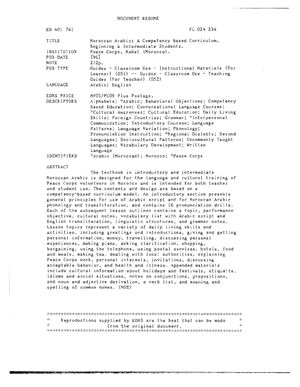Peace Corps, Rabat, 1996. 212 p.
The textbook in introductory and intermediate Moroccan Arabic is designed for the language and cultural training of Peace Corps volunteers in Morocco and is intended for both teacher and student use. The contents and design are based on a competency-based curriculum model. An introductory section presents general principles for use of Arabic script and for Moroccan Arabic phonology and transliteration, and contains 16 pronunciation drills. Each of the subsequent lesson outlines contains a topic, performance objective, cultural notes, vocabulary list with Arabic script and English transliteration, linguistic structures, and grammar notes. Lesson topics represent a variety of daily living skills and activities, including greetings and introductions, giving and getting personal information, money, travelling, discussing personal experiences, making plans, asking clarification, shopping, bargaining, using the telephone, using postal services, hotels, food and meals, making tea, dealing with local authorities, explaining Peace Corps work, personal interests, invitations, discussing acceptable behavior, and health and illness. Appended materials include cultural information about holidays and festivals, etiquette, idioms and social situations, notes on conjunctions, prepositions, and noun and adjective derivation, a verb list, and meaning and spelling of common names.
The textbook in introductory and intermediate Moroccan Arabic is designed for the language and cultural training of Peace Corps volunteers in Morocco and is intended for both teacher and student use. The contents and design are based on a competency-based curriculum model. An introductory section presents general principles for use of Arabic script and for Moroccan Arabic phonology and transliteration, and contains 16 pronunciation drills. Each of the subsequent lesson outlines contains a topic, performance objective, cultural notes, vocabulary list with Arabic script and English transliteration, linguistic structures, and grammar notes. Lesson topics represent a variety of daily living skills and activities, including greetings and introductions, giving and getting personal information, money, travelling, discussing personal experiences, making plans, asking clarification, shopping, bargaining, using the telephone, using postal services, hotels, food and meals, making tea, dealing with local authorities, explaining Peace Corps work, personal interests, invitations, discussing acceptable behavior, and health and illness. Appended materials include cultural information about holidays and festivals, etiquette, idioms and social situations, notes on conjunctions, prepositions, and noun and adjective derivation, a verb list, and meaning and spelling of common names.

